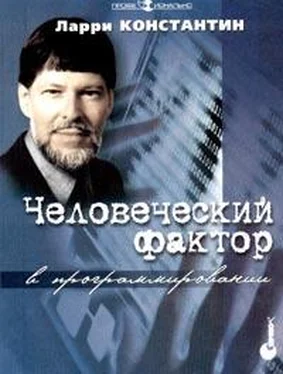[44] Jacobson, I., M. Christerson, P. Jonsson, and G. Overgaard. Object-Oriented Software Engineering: A Use Case Driven Approach. Reading, Mass.: Addison-Wesley.
[45] Kantor, D. K. and W. Lehr. 1975. Inside the Family: Toward a Theory of Family Process. San Francisco: Jossey-Bass.
[46] Kruchten, P. 2000. The Rational Unified Process. Reading, MA: Addison-Wesley.
[47] Larson, С. E. and F. M. J. LaFasto. 1989. TeamWork. Beverly Hills: Sage.
[48] Lickert, R. 1989. New Patterns in Management. New York: McGraw-Hill.
[49] Lockwood, L. A. D., and L. L. Constantine 1993. «From Events to Objects: The Heresy of Event-Orientation in a World of Objects», OOPSLA 92: Addendum to the Proceedings. New York, ACM Press.
[50] Mackenzie, D. D. 1966. «The Philosophy of Conventions», in Concepts in Program Design, L. L. Constantine, ed. Cambridge, Mass.: Information amp; Systems Press.
[51] Newmann, P. G. 1976. «Peopleware in Systems», in Peopleware in Systems 15–18. Cleveland, Ohio: Association for Systems Management.
[52] Nielsen, J. 1993. Usability Engineering. Boston: Academic Press.
[53] Norman, D. O. 1988. The Psychology of Everyday Things. New York: Basic Books.
[54] Page-Jones, M. 1980. Practical Guide to Structured Systems Design. New York: Yourdon Press.
[55] Page-Jones, M. 1995. What Every Programmer Should Know About Object-Oriented Design. New York: Dorset House.
[56] Page-Jones, M. 2000. Fundamentals of Object-Oriented Design in UML. Reading, MA: Addison-Wesley.
[57] Page-Jones, M., L. L. Constantine, and S. J. Weiss. 1990. «Modeling Object-Oriented Systems: A Uniform Object Notation», Computer Language 7(1), October.
[58] Plauger, P. J. 1993. Programming on Purpose II: Essays on Software People. Englewood Cliffs, N. J.: Prentice Hall.
[59] Priem, R. L. and К. H. Price. 1991. «Process and Outcome Expectations for Dialectical Inquiry, Devil's Advocacy, and Consensus Techniques of Strategic Decision Making», Group amp; Organizational Studies 16(2): 206-25.
[60] Rettig, M. 1990. «The Practical Programmer: Software Teams». Communications of the ACM 33(10), October.
[61] Sutherland, I.E. 1968. «SketchPad: A Man-Machine Graphical Communication System», in Proceedings, AFIPS Spring Joint Computer Conference. 1963. 23. pp. 329–346.
[62] Thomsett, R. 1990. «Effective Project Teams: A Dilemma, A Model, A Solution», American Programmer 3(7/8): 25–35.
[63] van Harmelan, M. (ed.) 2001. Object Modeling and User Interface Design. Harlow, England: Addison-Wesley.
[64] Ward, P. 1992. «The Evolution of Structured Analysis. Part II: Maturity and Its Problems», American Programmer 5(4): 18–29.
[65] Watzlawick, P., J. H. Beavin, and D. D. Jackson. 1967. Pragmatics of Human Communication. New York: Norton.
[66] Weinberg, G. M. and E. L. Schulman. 1974. «Goals and Performance in Computer Programming», Human Factors 16(1): 70–77.
[67] Whitchurch, G. G. and L. L. Constantine. 1992. «Systems Theory», in Sourcebook of Family Theories and Methods: A Contextual Approach, P. B. Boss et al., eds. New York: Plenum.
[68] Wirfs-Brock, R., B. Wilkerson, and L. Weiner. 1990. Designing Object-Oriented Software. Englewood Cliffs, N.J.: Prentice Hall.
[69] Wood, J. and D. Silver. 1989. Joint Application Design. New York: John Wiley amp; Sons.
[70] Yourdon, E., and L. L. Constantine 1974. Structured Design, first printing. New York: Yourdon, Inc.
[71] Zahniser, R. A. 1990. «Building Software in Groups», American Programmer 3(7/8): 50–56.
[72] Zahniser, R. A. 1993. «Design by Walking Around», Communications of the ACM 36(10), October.
CASE (computer-aided software engineering) — автоматизированное проектирование и создание программ. — Примеч. науч. ред.
Т. ДеМарко и Т. Листер «Человеческий фактор: эффективные проекты и команды».
Число, выведенное в 1956 году психологом Джорджем Миллером, относится к возможности человека обрабатывать в кратковременной памяти только от пяти до девяти элементов.
После смерти (лат.).
Научно-исследовательские и опытно-конструкторские работы.
В отличие от английского языка, в котором слово «file» существует давно, в русский язык слово «файл» вошло сравнительно недавно (с-развитием информационных технологий). Слово «папка» вошло в компьютерный лексикон из обычной речи
Слово lisp в переводе с англ. означает «шепелявить». Именно это и обыгрывает автор (thpeak with a lithp нужно понимать как speak with lisp). Из-за особенностей синтаксиса LISP часто расшифровывают (в шутку, конечно) как Lots of Idiotic exceSsive Parentheses или Lots of Irritating Superfluous Parentheses, подразумевая, вероятно, что нормально «говорить» на подобном языке нельзя.
[Делом свершенным (фр.).
АСК (сокр. от англ. acknowledgement) — подтверждение приема.
NAK (сокр. от англ. negative acknowledge) — отсутствие подтверждения приема.
NMI (сокр. от англ. nonmaskable interrupt).
IRQsome, здесь обыгрывается англ. irksome — надоедливый, докучливый.
Trail boss (амер., устар. от trail — тропа и boss — начальник). На Диком Западе это старший группы ковбоев, ответственный за скот и погонщиков при перегоне табуна
Chiles rellenos — фаршированные перцы, Мексика; torn kah gai — суп из молока кокоса, Таиланд; szekely goulash — гуляш, Трансильвания; pesto sauce — соус из листьев базилика, Италия; lamb vindalo — баранина, приготовленная с острой приправой карри, Индия; coq au vin — курица в красном вине, Франция; strange-flavored beef — мясо с овощами, грибами и молодой кукурузой, Китай; pasta primavera — блюдо из макарон со свежими овощами, Италия; paella — блюдо из моллюсков и морепродуктов, Испания; feijoada — тушеное мясо с черными бобами, Бразилия.
Читать дальше
Конец ознакомительного отрывка
Купить книгу










